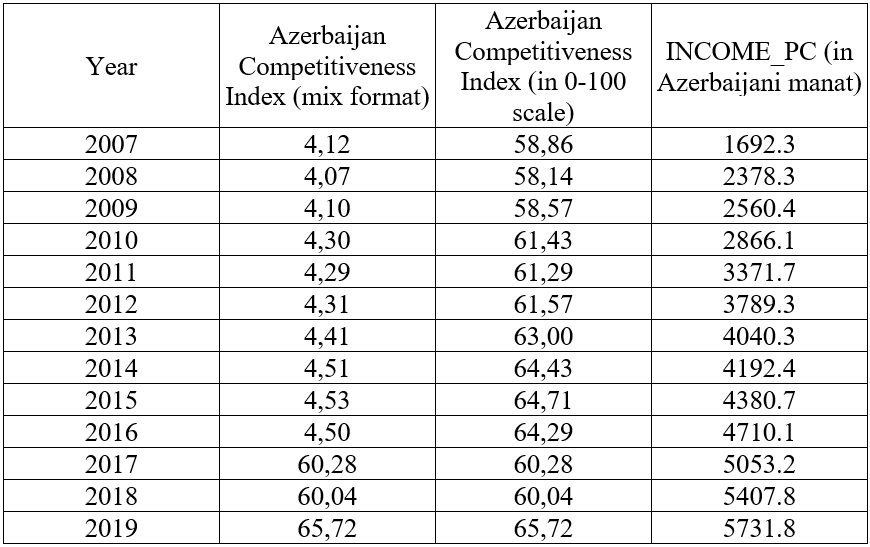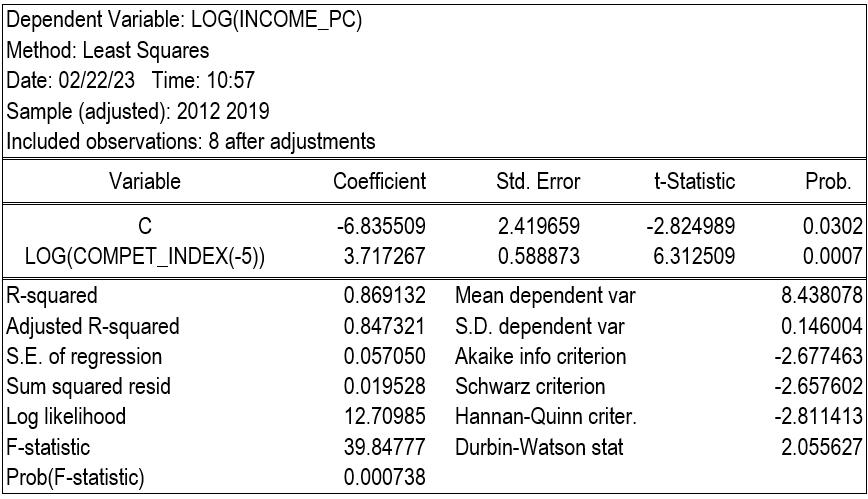Econometric Assessment of the Impact of Competitiveness on the Income of the Population in Azerbaijan
Yadulla Hamdulla oglu Hasanli
SRIES, Azerbaijan State University of Economics (UNEC), Baku, Azerbaijan
Sardar Ahmadiyya oglu Shabanov
SRIES, Azerbaijan State University of Economics (UNEC), Baku, Azerbaijan
Introduction
The concept of global competitiveness index (GCI) was proposed in 2004 [9]. The GCI index is calculated by the World Economic Forum since 2007. The GCI is an aggregate indicator that includes more than 110 sub-indicators in 12 groups. According to the values of this indicator, the countries of the world are ranked in descending order [11, 12]. GCI indicator consists of the following groups:
- Institutes (institutions)
- Adequate infrastructure
- Stable macroeconomic framework
- Health and primary education
- Higher education and training
- Efficient commodity markets
- Efficient labor markets
- Developed financial markets
- Ability to use existing technology
- Market size (domestic and international)
- Production of new and different goods using the most complex production processes
- Innovation.
It is clear that international competitiveness covers all spheres of a country’s life – political, social, economic and cultural – and ultimately plays a leading role in the well-being of the country’s population. One of the important components of well-being is the income of the population. In this article, the issue of the impact of competitiveness on the income of the population was considered in the case of Azerbaijan.
1. Literature review
The concept of competitiveness has been widely interpreted in the economic literature. One of the most widespread articles in this field [8] belongs to Porter. In this article, Porter indicated four main factors of countries’ competitiveness: factor conditions, demand conditions, firm strategy, structure and rivalry, related and supporting industries. The article [14] examines the impact of national competitiveness on productivity, economic growth and per capita income in a number of post-Soviet countries (Moldova, Ukraine, Armenia, Georgia, Azerbaijan, Kazakhstan and Russia). It shows that the Global Competitiveness Index (GCI) has a high correlation with the level of productivity, and selected post-Soviet countries with high national competitiveness had higher long-term economic growth and per capita income. It was determined that GCI contributed positively and statistically significantly to the increase of the income level in the considered post-Soviet countries in 2004-2018. The article [10] examined the relationship between competitiveness and per capita income in countries with natural resources and drew specific conclusions on Nigeria. The aim of the article [4] was to provide insights into the role of competitiveness in promoting economic growth and development in the context of Iran. By evaluating the relationship between GCI and economic growth, the authors shed light on the factors that contribute to or hinder economic progress in Iran and other comparable countries. The main idea of the article [13] was to identify and analyze the main factors that drive competitiveness in the European Union (EU) member states. The authors tried to clarify the determinants of competitiveness and their impact on the economic performance of the EU-28 countries. They examined a wide range of factors affecting competitiveness, such as innovation, human capital, infrastructure, business environment and institutions. In this article, empirical analysis and statistical methods were used to evaluate the relationship between these factors and competitiveness indicators. The article examines the key drivers of competitiveness, providing insights and policy recommendations to increase the competitiveness of EU member states. The paper’s findings can help policymakers and stakeholders identify areas that require attention and investment to improve economic performance, promote growth, and maintain long-term competitiveness. The main idea of the paper [1] is to investigate the relationship between GCI and economic growth in developed and developing countries. The authors assessed the impact of the GCI, a widely recognized indicator of competitiveness, on economic growth in selected countries. They used quantitative methods and statistical analysis to examine the relationship between GCI score and economic growth indicators. The model estimation results show that GCI score has positive and significant effects on per capita GDP growth in selected developed countries, and a 10% increase in a country’s GCI score will lead to a 17.33 percentage point increase in economic growth. This value is 15.49 percentage points for selected developing and emerging countries. The results of this paper show that compared to the GCI score; the “net growth rate” reveals a positive and strong correlation, which is consistent with the idea that the GCI is a good indicator of an economy’s level of productivity or competitiveness. The main idea of the article [5] is to identify and analyze the factors affecting the competitiveness of national economies, with special attention to per capita income as an indicator. By examining countries’ per capita incomes, the authors attempted to identify the determinants that contribute to the competitiveness of their economies. They examined various factors that can affect per capita income, such as economic policy, infrastructure, education, technological advances, trade openness, and institutional quality. The article aims to shed light on the determinants of national competitiveness by analyzing these factors and their impact on per capita income. Using quantitative analysis and statistical methods to assess the relationship between identified factors and per capita income, the authors provide insights into the drivers of economic performance and competitiveness. The results of the study can contribute to a better understanding of the factors that promote or hinder economic competitiveness, and provide valuable information for policymakers and stakeholders in the development of strategies and policies that increase national competitiveness and improve the level of per capita income. The purpose of this paper is to conduct an empirical analysis to identify the factors that are important in the construction of GCI. From the latter study, it can be concluded that the determining factors of a nation’s global competitiveness depend on its development level. The role of factors in the construction of the global competitiveness index is different. In all countries, the most powerful factor influencing global competitiveness is the business environment. Next, come the factors of infrastructure and innovation, institutions and governance, education and telecommunications. The article [3] shows that economic growth is associated with both price and non-price competitiveness factors, for example, as other studies show, with education [6, 7] and knowledge dissemination [2]. Here we are talking about different pillars of the GCI index. Gaining competitiveness is a key objective for the medium and long term, and has a significant impact on improving living standards by boosting economic growth. The analysis can be extended by using other measures of competitiveness (e.g. export market shares) as well as disentangling the effects of different components of the GCI. This includes infrastructure, institutions, etc., among the pillars that have a strong impact on economic development in EU countries. It should be noted that a brief overview of the numerous literatures available in this field leads to the conclusion that the country’s competitiveness has a positive effect on its economic growth, population welfare, and per capita income.
2. Dataset and model specification
It should be noted that in the relevant literature, the global competitiveness index was evaluated on a scale of 0-7 for the years 2007-2015, and on a scale of 0-100 starting from 2016. Considering this point, the values on the 0-7 scale were transferred to the 0-100 scale, and the dataset was formed and described in the following table.
Table 1. Dataset

Source: author’s calculations based on official data of SSC AR and weforum.org
The model specification is as follows:
LOG(INCOME_PC) = C(1) + C(2)*LOG(COMP_INDEX(-5))
(1)
Here, INCOME_PC shows per capita income (in Azerbaijani manat), and COMP_INDEX shows Azerbaijan’s international competitiveness index (on a scale of 0-100).
3. The main result
The corresponding regression equation is constructed as follows:
LOG(INCOME_PC) = -6.83550866357 +
+ 3.71726679545*LOG(COMPET_INDEX(-5))
(2)
The main statistical characteristics of the model are described in table 2 below.
Table 2. The main statistical characteristics of the model

The economic interpretation of the model is that 1% increase in Azerbaijan’s international competitiveness index increases the per capita income of the population by 3.72% with a 5-year delay. We explain the 5-year delay by the fact that the international competitiveness index is an aggregate indicator consisting of 110 sub-indices, which are grouped in 12 directions. These groups cover almost all areas of economic, social and cultural life. Naturally, these points lead to the fact that per capita incomes are realized as a unity of numerous combinations through various mechanisms. Note that the calculations were performed using the Eviews application package. All necessary tests were performed (correlogram of residuals, Jacque-Bera normality test, Breusch-Pagan-Godfrey test to check whether the residuals are heteroscedastic, ADF test to check whether the residual series is stationary) and the constructed model is adequate.
4. Conclusion
In the article, the effect of competitiveness on the income of the population in the example of Azerbaijan was evaluated econometrically. The assessment was carried out for the global international competitiveness index and per capita income indicators. It was determined that the international competitiveness index has a positive effect on the per capita income of the population with a certain time delay. The fact that the positive effect occurs with a certain delay is related to the fact that the per capita income is realized both directly and indirectly and through various mechanisms under the influence of various factors. International competitiveness is a driver of socio-economic and cultural development, and its positive impact on per capita income, which is one of the main components of human well-being, matches the relevant theoretical provisions of economic theory and the results obtained in relevant scientific literature.
References
- Bafandeh Imandoust S., Mofidi A. Measuring the impact of global competitiveness index (gci) on economic growth in selected developed and developing countries. Journal of Economics and Regional Development. 2017. Vol. 23. №. 12. P. 65-95. https://doi.org/10.22067/erd.v23i12.57262. (date of application: 21.05.2023).
- Boiko A., Kramarenko O., Shabanov S. The State of Dissemination of Open Research Data in Ukraine and the World: Bibliometric Analysis. European Journal of Management Issues. 2021. Vol. 29. №. 4. P. 209-217. https://doi.org/10.15421/192120. (date of application: 21.05.2023).
- Cazacu A. M. et al. Global Competitiveness Index and economic growth. In International Finance and Banking Conference. 2015. P. 369-381. URL: https://www.researchgate.net/profile/Ana-Maria-Cazacu/publication/335618896_Global_Competitiveness_Index_and_economic_growth/links/5d70a8764585151ee49e570a/Global-Competitiveness-Index-and-economic-growth.pdf#page=369.
- Dadgar Y., Nazari R., Fahimifar F. The impact of Global Competitiveness Index (GCI) on Economic Growth in Iran and some selected countries. OIDA International Journal of Sustainable Development. 2018. Vol. 11. №. 12. P. 53-60. URL: https://ssrn.com/abstract=3340682 (date of application: 21.05.2023).
- Gdairia A., Sellaouti F. Determinants of national economies’ competitiveness based on per capita income. China-USA Business Review. 2018. Vol. 17. P. 122-134. URL: https://www.davidpublisher.com/Public/uploads/Contribute/5b06385c0372d.pdf (date of application: 21.05.2023).
- Hajiyev N., Shabanov S., Hasanli Y. Econometric Evaluation of Impact of Education Quality on Economic Growth in Azerbaijan. Turkish Journal of Computer and Mathematics Education (TURCOMAT). 2021. Vol. 12. №. 6. P. 1397-1404. https://doi.org/10.17762/turcomat.v12i6.2484.
- Hasanli Y., Shabanov S. Estimation of Impact of Innovations on the Quality of Tertiary Education. The 6th International Conference on Control and Optimization with Industrial Applications. 2018. P. 185-187. https://dx.doi.org/10.2139/ssrn.4323632.
- Porter, M. E. The competitive advantage of nations. Harvard Business Review. 1990. Vol. 68. №2. P. 73-93.
- Sala-i-Martin X., Artadi E. V. The global competitiveness index. The global competitiveness report. 2004. Vol. 2005. P. 51-80.
- Sala-i-Martin X., Subramanian A. Addressing the natural resource curse: An illustration from Nigeria. Journal of African Economies. 2013. Vol. 22. №. 4. P. 570-615. https://doi.org/10.1093/jae/ejs033.
- Schwab K. The global competitiveness report 2018. – World Economic Forum, 2018. URL: https://www.weforum.org/reports/the-global-competitveness-report-2018/ (date of application: 21.05.2023).
- Schwab K. The global competitiveness report 2019. – World Economic Forum, 2019. URL: http://www3.weforum.org/docs/WEF_TheGlobalCompetitivenessReport2019.pdf (date of application: 21.05.2023).
- Simionescu M. et al. The main drivers of competitiveness in the EU-28 countries. Journal of Competitiveness. 2021. Vol. 13. №. 1. P. 129. https://doi.org/10.7441/joc.2021.01.08.
- Sodikov A. et al. Impact of national competitiveness on economic growth and income level–evidence from the selected post-Soviet countries. Res. World Econ. 2021. Vol. 12. №. 2. P. 17-36. https://doi.org/10.5430/rwe.v12n2p17.

